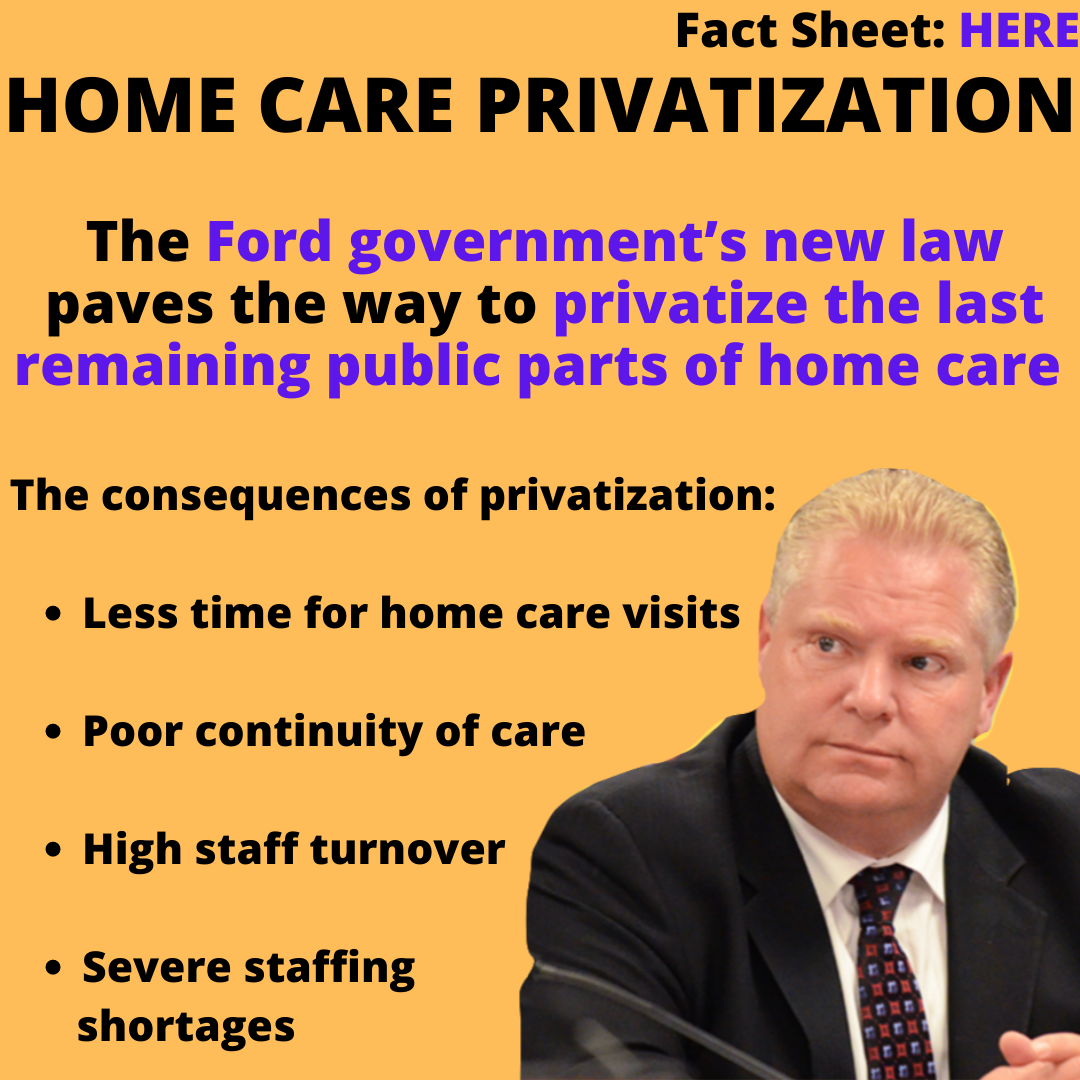
FACT SHEET: Home Care Privatization
Posted: March 8, 2022
(March 8, 2022)
The privatization of home care in Ontario
Home care provides individuals with complex medical conditions care in the comfort of their homes and enables the frail elderly to live at home as long as possible. Under the jurisdiction of the Ministry of Health (MOH), home care services may be government-funded but are accessible to eligible clients only. People who do not qualify for publicly funded home care have to pay out-of-pocket for home care or go without. Privatization of who pays for home care means the change from when care is covered publicly through our tax dollars and is provided without charge when people need it, to a system where care has to be bought and paid for by people individually when they are sick, disabled or elderly.
In 1996, Ontario’s former Conservative Premier Mike Harris began the systematic privatization of home care. They brought in for-profit companies to bid for services against the non-profit Victorian Order of Nurses (VON), the VHA, Red Cross, and others. Over the years, for-profit organizations continuously took over more and more of the services. These include home visits by nurses and PSWs, and rehabilitation services. The consequences of privatization have been devastating. They include:
- Severe staffing shortages
- High staff turnover
- Frequent changes to home care clients’ nurses and personal support workers – poor continuity of care
- Less time for home care visits, strict rationing
- Millions of public dollars siphoned off for profits and duplicate administration
Now, the Ford government is planning to expand the privatization of home care. They brought in a new law in the summer of 2020 that guts the former home care legislation including vital protections for patients, and sets up the privatization of the last remaining publicly controlled parts of home care. This will result in the end of public oversight and privatization of the final remaining public parts of home care if we do not stop it.
Profits are taken from public funds that should go to improve staffing & care
Staff working in for-profit home care organizations have a high turnover rate with poorer working conditions and wages. In 2015, Ontario’s Auditor General reported that 62% of the $2.4 billion public funding for CCAC is given to private home care companies. The following chart describes what private home care companies are charging the public purse for each hour of nursing care and personal support workers (PSWs) compared to how much the front-line staff are actually paid:
| Ontario Auditor General’s Report 2015 | ||
| Private for-profit home care staff | How much private home care companies are paid by public funds per hour | How much private home care companies are actually paying front-line staff |
| Nurse | $58.20 – $70.60 | About $30 per hour |
| PSW | $29.50 – $48.98 | About $15 per hour |
This gives a sense of how much money is siphoned away from care for profit and administration by the for-profit home care corporations.
The Ford government’s new law paves the way to privatize the last remaining public parts of home care
Bill 175, the Ford government’s new home care privatization law, affects more than 730, 000 Ontarians who use home care services and it:
- Benefits private interests to profit off of home care services and increase their “market share” (i.e. how much of our public funding for home care they get).
- Allows many private organizations to take over public home care services without governance, without any public accountability structure and without public interest protections.
- Removes the Bill of Rights for home care clients – which includes respect, refusal, and consent, raising concerns without fear of reprisal, and other home care rights. In the new law, this has been revoked and will not be in legislation but rather is supposed to be put into regulations which are easier to change.
- Contains no provisions to improve access to care, equity, quality of care and staffing shortages.


